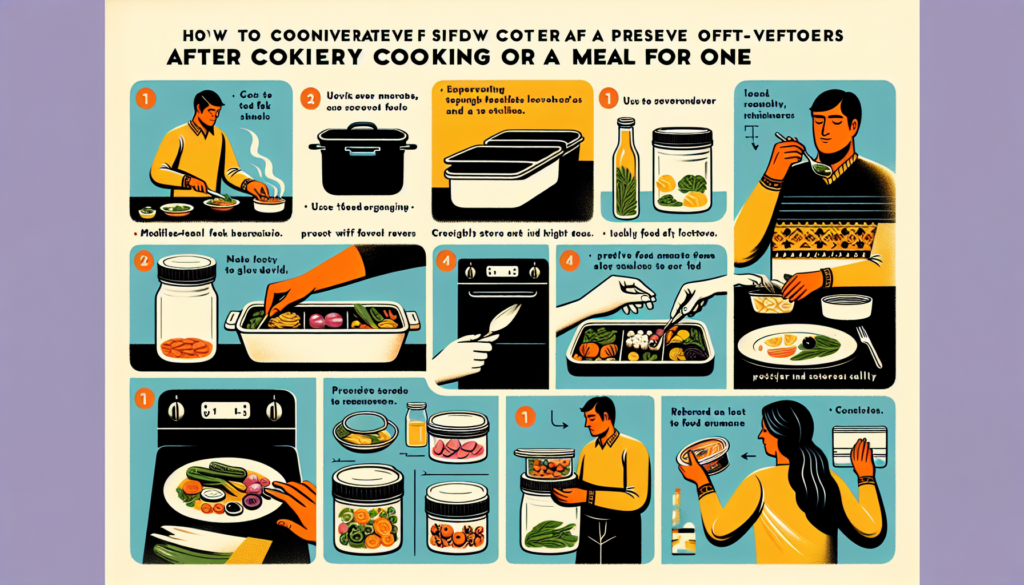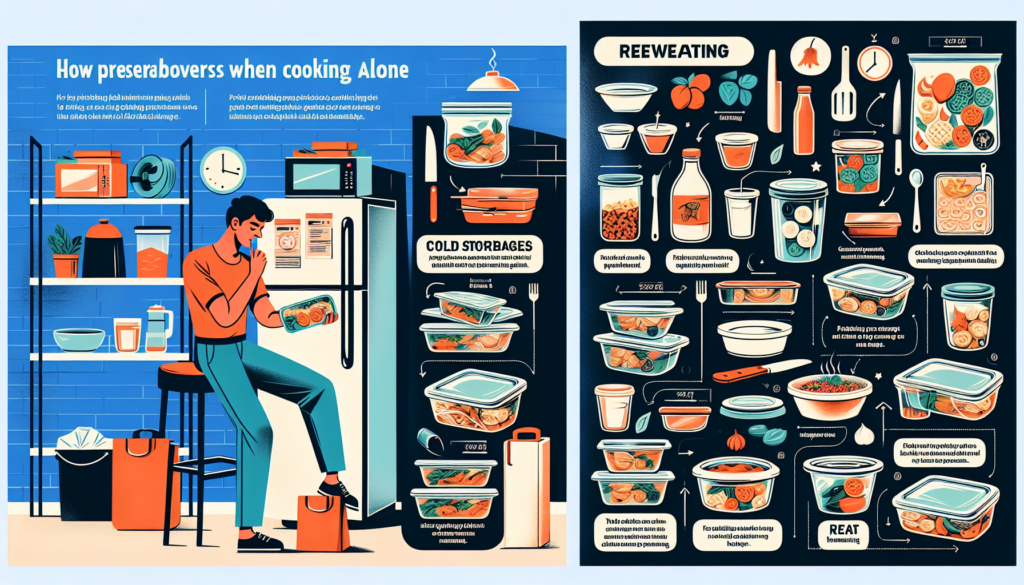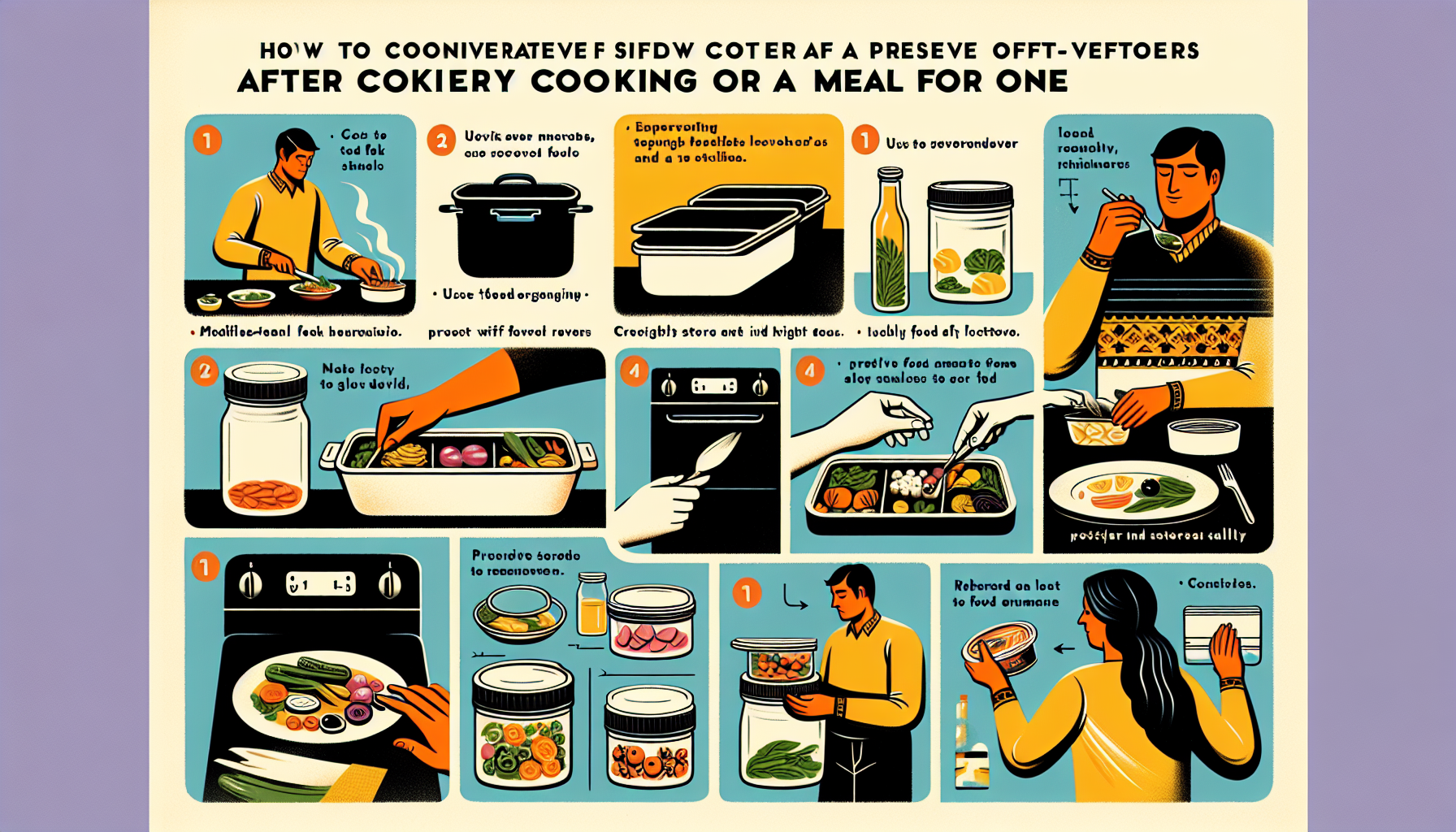Are you tired of throwing out half-eaten meals when cooking for yourself? Leftovers can be a lifesaver for busy individuals, but they often go to waste due to improper preservation techniques. In this article, we will explore essential techniques for preserving leftovers when cooking solo. Whether you’re a seasoned chef or just beginning your culinary journey, these tips will help you make the most of your meals and reduce food waste. So grab your apron and get ready to discover the secrets to preserving your delicious creations!

Understanding the Importance of Preserving Leftovers
Prolonging the Shelf Life of Leftovers
When it comes to cooking solo, preserving leftovers becomes crucial. By properly storing and handling your leftovers, you can significantly prolong their shelf life. This means you can enjoy your tasty creations for a longer period of time, reducing the need for constant cooking and saving you the hassle of meal preparation every day.
Reducing Food Waste
Preserving leftovers also plays a vital role in reducing food waste. According to studies, a significant amount of food is wasted each year. By making use of leftovers, you contribute to minimizing this waste and help create a more sustainable food system. Every little step we take to prevent food waste counts, and preserving leftovers is an essential technique in achieving this goal.
Saving Time and Money
Another significant benefit of preserving leftovers is the amount of time and money it can save you. By cooking larger portions and storing the leftovers, you minimize the need for frequent grocery trips and intensive meal preparation. Instead, you have ready-to-eat meals that can be quickly reheated, allowing you to focus on other aspects of your day and saving you from the hassle and expense of eating out.
Storage Containers for Leftovers
Choosing the Right Containers
Selecting the appropriate storage containers for your leftovers is essential to ensure their freshness and maintain their quality. Opt for airtight containers that prevent any air from entering, as exposure to air can lead to faster spoilage. Glass or BPA-free plastic containers are good options, as they are safe for reheating in the microwave or oven. Additionally, consider the size of the container to avoid wasting valuable space in your fridge or freezer.
Options for Single Servings
If you frequently cook solo, investing in containers specifically designed for single servings can be a great idea. These containers come in various sizes, allowing you to portion your leftovers accordingly. Not only do they help with portion control, but they also make reheating a breeze, as you can simply take out one container at a time without having to defrost a large batch.
Stackable and Space-Saving Containers
When dealing with limited storage space, stackable and space-saving containers are a game-changer. These containers are designed to fit neatly on top of one another, maximizing the use of vertical space in your fridge or freezer. Look for containers that securely interlock to prevent the risk of accidental spills or messes.
Proper Refrigeration of Leftovers
Cooling Down Leftovers
To properly store leftovers, it is crucial to allow them to cool down before refrigerating. Leaving hot food in the fridge can affect the overall temperature and cause other perishable items to spoil. Let your leftovers cool on the countertop for about 30 minutes to an hour, or until they reach room temperature. After cooling, promptly transfer them to an airtight container and place them in the refrigerator.
Storage Temperature
The temperature at which you store your leftovers plays a vital role in maintaining their quality. The refrigerator temperature should be set to 40°F (4°C) or below to inhibit the growth of harmful bacteria. It is crucial to regularly check and monitor the temperature of your fridge to ensure that it is consistently maintaining the ideal temperature for food storage.
Avoiding Overcrowding in the Fridge
It is essential to avoid overcrowding your refrigerator when storing leftovers. Overcrowding restricts airflow and prevents proper cooling, increasing the risk of food spoilage. Arrange your containers to allow for adequate space between them, ensuring optimal air circulation. Proper organization and avoiding overcrowding also make it easier to locate specific leftovers when you need them.
Freezing Leftovers for Long-Term Preservation
Labeling and Dating Frozen Leftovers
When it comes to freezing leftovers, proper labeling and dating are crucial steps. Clearly label each container with the name of the dish and the date it was frozen. This practice ensures that you can easily identify the contents of each container and helps you keep track of the storage time. It is recommended to consume frozen leftovers within 2-3 months for the best quality.
Using Freezer-Safe Containers
Not all containers are suitable for freezing leftovers. Ensure that the containers you use are specifically labeled as freezer-safe. Freezer-safe containers are designed to withstand the extreme temperatures of the freezer without cracking or breaking. Avoid using containers made of glass with narrow necks, as they are prone to shattering when the food expands upon freezing.
Proper Thawing Techniques
When it’s time to enjoy your frozen leftovers, proper thawing techniques are essential to maintain their texture and taste. The safest way to thaw leftovers is by transferring them from the freezer to the refrigerator and allowing them to thaw slowly overnight. This gradual thawing process ensures even defrosting and reduces the risk of bacterial growth. Alternatively, you can use the defrost setting on your microwave or thaw the leftovers in a sealed bag submerged in cold water.

Techniques for Reheating Leftovers
Microwaving Leftovers
Microwaving is one of the quickest and easiest methods for reheating leftovers. However, it’s important to follow some guidelines to ensure even heating and prevent hot spots. Place your leftovers in a microwave-safe container with a lid or cover them loosely with a microwave-safe plate, allowing steam to escape. Stir the food midway through to promote even heating, and check the internal temperature to ensure it reaches a safe temperature before consuming.
Using the Oven to Reheat
The oven is an excellent option for reheating larger quantities of leftovers or dishes that require a crispy finish. Preheat your oven to the appropriate temperature suggested for the specific dish and place the leftovers in a baking dish or oven-safe container. Cover the dish with foil to prevent excessive drying and bake until the food is heated through. For dishes that require a crispy texture, remove the foil towards the end of the reheating process.
Stovetop Reheating Methods
Certain dishes, such as soups, stews, or stir-fries, can be easily reheated on the stovetop. Place the leftovers in a saucepan or skillet over medium heat and stir occasionally to ensure even heating. If the dish appears dry, you can add a small amount of liquid, such as broth or water, to prevent sticking and maintain its moisture. Once the food reaches a safe temperature, it is ready to be enjoyed.
Utilizing Leftovers in New Dishes
Repurposing Leftovers for Quick Meals
One of the joys of leftovers is the opportunity to transform them into new and exciting meals. Repurposing leftovers allows you to create quick and delicious dishes without much effort. For example, leftover roasted chicken can be shredded and used in salads, tacos, or sandwiches. Leftover pasta can be turned into a flavorful pasta salad by adding fresh vegetables and dressing. Let your creativity guide you as you give new life to your leftovers.
Combining Leftovers for Flavorful Recipes
Combining different leftovers can lead to unique and flavorful recipes. For instance, combine leftover grilled vegetables and cooked quinoa to create a nutritious and satisfying grain bowl. Leftover cooked meat can be combined with vegetables and rice to make a delicious stir-fry. The possibilities are endless when you let your imagination run wild and experiment with different flavor combinations.
Transforming Leftovers into Casseroles
Casseroles are a fantastic way to utilize multiple leftovers and create a meal that is both comforting and satisfying. Layering leftover mashed potatoes, cooked vegetables, and shredded cheese can result in a delicious and hearty potato casserole. Leftover cooked pasta can be combined with a creamy sauce, vegetables, and cheese to make a mouthwatering pasta bake. Casseroles not only help minimize food waste but also make meal preparation a breeze.
Ways to Prevent Leftover Spoilage
Avoiding Cross-Contamination
Cross-contamination is a leading cause of food spoilage and can lead to foodborne illnesses. To prevent cross-contamination when storing leftovers, make sure to use separate containers for different types of food. Raw meats, poultry, and seafood should never come into contact with cooked or ready-to-eat foods. Additionally, use different utensils and cutting boards for handling raw and cooked foods to minimize the risk of bacterial contamination.
Checking for Off Odors or Mold
Before consuming any leftover, it is essential to inspect it for any signs of spoilage. Off odors or mold growth are clear indications that the food has gone bad and should not be consumed. If you notice any unusual smells or visual changes, discard the leftovers immediately. It is always better to err on the side of caution and prioritize your health and safety.
Proper Storage Timeframes
While leftovers can be a convenient and delicious option, it is important to be mindful of their storage timeframes. As a general rule, refrigerated leftovers should be consumed within 3-4 days to ensure freshness and reduce the risk of foodborne illnesses. Frozen leftovers, on the other hand, can be safely consumed within 2-3 months for optimal quality. Regularly check the storage timeframes and prioritize consuming the oldest leftovers first.
Organizing and Labeling Leftover Storage
Creating a System for Easy Retrieval
To efficiently manage your leftover storage, creating an organized system is key. Group similar items together, such as all cooked meats or all vegetable-based dishes, to facilitate easy retrieval. Consider using stackable storage containers to maximize space utilization. Additionally, arrange your leftovers in an orderly manner, placing the oldest ones towards the front for quick visibility and consumption.
Using Labels and Marker Pens
Labels and marker pens are valuable tools when it comes to organizing and managing leftover storage. Clearly label each container with the name of the dish and the date it was prepared or frozen. This labeling system ensures that you can easily identify the contents without having to open every container. Use waterproof and smudge-resistant markers to prevent any vital information from fading over time.
Grouping Leftovers by Type
Grouping leftovers by type helps streamline the process of selecting meals based on your cravings or dietary preferences. Keep all pasta-based dishes together, meats in a separate section, and vegetable-based dishes in another. This organization makes it easier to assess your options and plan your meals accordingly. By grouping similar leftovers together, you can quickly decide what to eat without wasting time searching through the entire storage area.
Maximizing the Shelf Life of Leftovers
Consideration of Ingredients
Certain ingredients have a shorter shelf life than others, even when properly stored. Take into account the perishability of different ingredients when planning your meals and prioritizing which leftovers to consume first. For example, delicate leafy greens or seafood should be consumed within a day or two, while cooked grains or stews can last longer in the fridge. By considering the ingredients’ shelf life, you can minimize waste and prioritize safety.
Proper Packaging Techniques
Proper packaging is essential to maximize the shelf life of leftovers. Make sure to remove excess air from containers to prevent spoilage and maintain freshness. For foods with high moisture content, such as soups or sauces, consider using freezer-grade zip-top bags to eliminate air pockets. Additionally, wrap individual portions tightly in plastic wrap before placing them in containers to prevent freezer burn and maintain the quality of the food.
Optimal Storage Times for Different Foods
Different foods have varying shelf lives, and it is important to be aware of the optimal storage times to ensure food safety. As a general guideline, cooked meats and poultry can be refrigerated for 3-4 days, while cooked rice and grains can last up to a week. Dairy-based dishes such as casseroles should be consumed within 3-4 days, while bread and baked goods can be stored for about 2-3 days before they lose their freshness.
Recipes and Ideas for Cooking Solo
Meal Planning for Solo Cooking
Meal planning is a fantastic way to stay organized and ensure you have delicious meals throughout the week. When cooking solo, creating a meal plan can help you make the most of your leftovers. Plan your meals in advance, taking into account the ingredients you already have on hand and incorporating leftover utilization into your recipes. This approach will not only save you time but also lead to more satisfying and diverse meals.
Recipes Tailored for Single Portions
Finding recipes tailored for single portions can make cooking solo a breeze. Look for recipes that provide specific measurements for one serving or adjust the ingredient quantities accordingly. You can find numerous resources, such as cookbooks or online platforms, that specialize in single-serving recipes. These recipes eliminate the need for extensive calculations or excessive leftovers, allowing you to enjoy a perfectly portioned meal every time.
Creative Ways to Use Leftovers
Cooking solo doesn’t mean you have to eat the same leftovers in the same way every time. Get creative and explore different ways to use your leftovers to create exciting and flavorsome dishes. For example, leftover roasted vegetables can be blended into a tasty soup or turned into a vibrant veggie wrap by adding a spread and some fresh greens. Get inspired by online recipe communities or experiment with your own ideas to make the most of your leftovers.
By understanding the importance of preserving leftovers when cooking solo, you can enjoy the benefits of prolonged shelf life, reduced food waste, and savings in time and money. From choosing the right storage containers to properly refrigerating, freezing, and reheating leftovers, implementing these techniques ensures maximum freshness and flavor. Additionally, utilizing leftovers in new dishes and preventing spoilage through careful storage and organization optimizes your culinary experience. With a little planning and creativity, you can transform simple leftovers into delicious meals tailored to your preferences. So, embrace the art of preserving leftovers and discover the vast possibilities that lie within your refrigerator.
